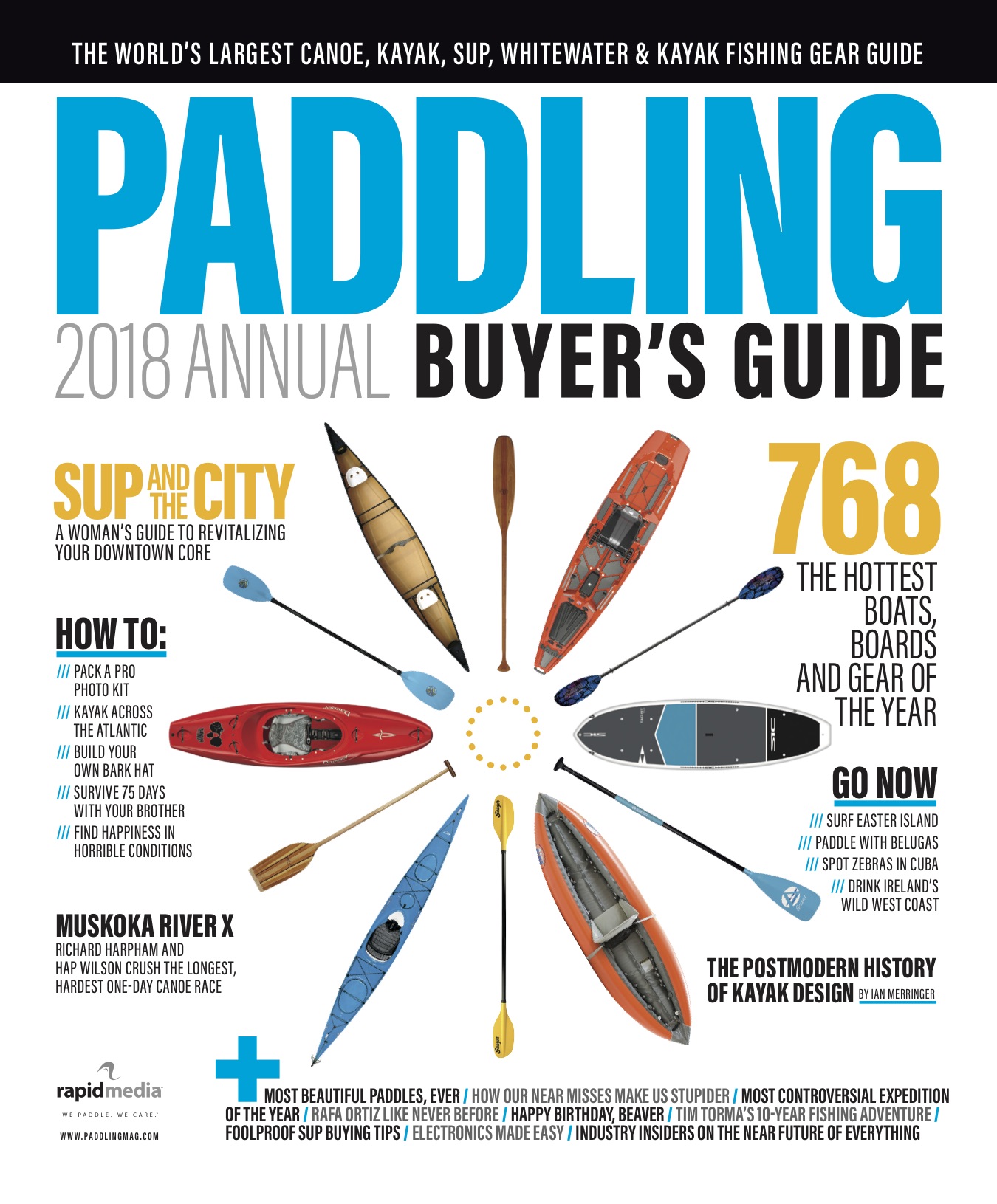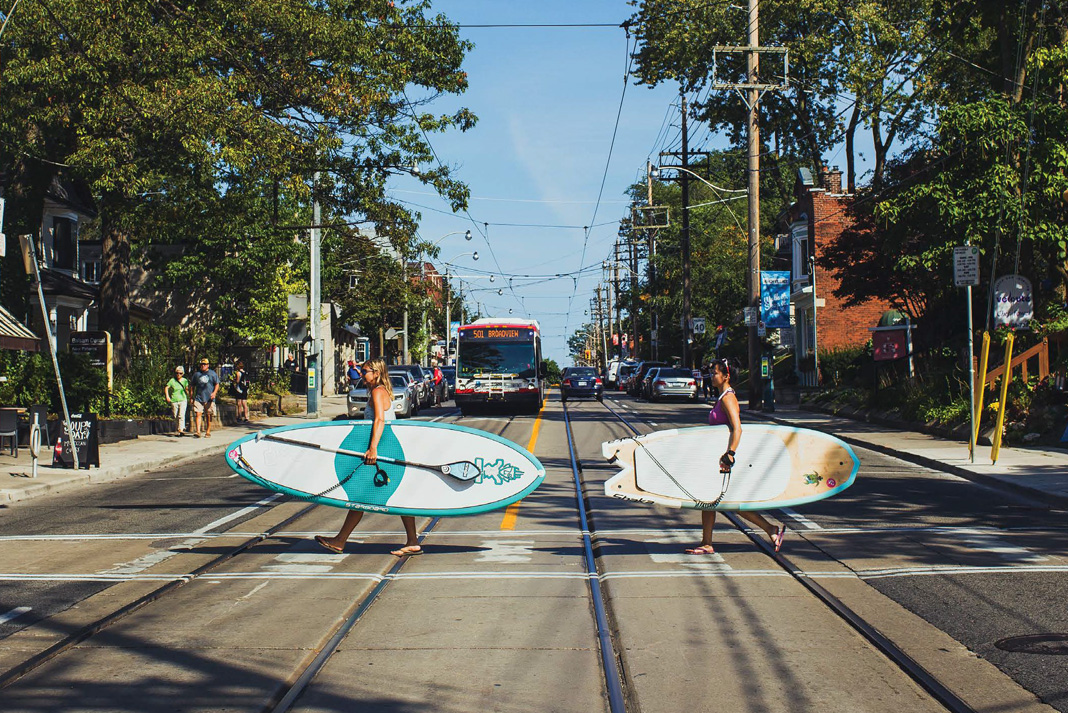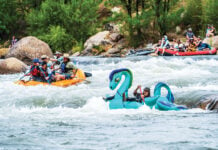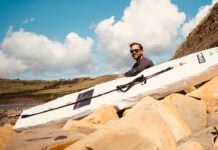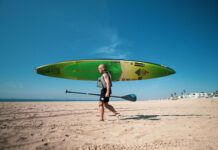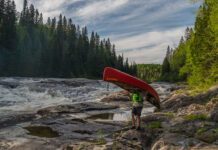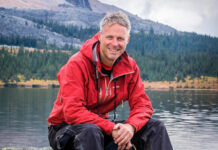It’s a warm fall day in my hometown of Toronto. The sounds of sidewalk life, traffic and streetcars filter through the door of the cafe where I meet Diana Lee and Janna Van Hoof. Over lattes, we discuss their shared passion and the city’s hot, new summer pastime—standup paddleboarding.
Paddleboarding is reshaping Toronto’s waterfront access
The two women are at the forefront of a growing tribe. Almost 5,000 miles away from SUP’s Hawaiian roots, North America’s fourth-largest city might seem like an unlikely hotspot for SUP culture. Yet, perched on the shining blue expanse of Lake Ontario, paddleboarding is reshaping Toronto’s waterfront access and the lives of its locals.
There is no better face to put to this trend than Diana Lee. By day she is a librarian with the Toronto Public Library; by night she’s an adventure sports junkie. She’s determined to defy the stereotypes of her profession—instead of meek and mild, she’s a bubbly adventure racer, wilderness tripper, and dragon boat paddler. Paddleboarding has captured her interest above all other sports. Just about every photo blasted out to her Instagram followers and many of the outdoor events she covers for local outdoor magazines feature paddleboarding in some form. Lee just wants everyone to have as much fun on the water as she’s having.
Since 2010, the number of paddleboarders in North America has exploded. According to the Outdoor Industry Association, SUP was the fastest growing outdoor activity from 2013 to 2016, growing at an average rate of 18 percent—or 250,000 participants—per year. Newbies are attracted to the ease of getting on the water—just grab a board, PFD, paddle and go. For some it’s a one-time excursion, but for others— Lee among them—it’s a life-altering passion.
Lee’s enthusiasm is borderline evangelical. She’s quick to advise me on the best local spots to get on the water. “I paddle everywhere. Often out of Cherry Beach for the sunsets and the skyline, and Kew Balmy Beach for the best unobstructed sunrises,” she tells me.
In just a few minutes of conversation I realize that in my decades of canoeing, kayaking and paddleboarding in this city, I’ve only scratched the surface of the destinations I could go. From the bustling downtown inner harbor, to the secluded waterways of the Toronto Islands, there’s no shortage of hotspots and Lee makes each sound positively dreamy.
Lee also enthusiastically rhymes off a dozen things to do on a paddleboard, from nighttime excursions to day-long trips to camping—an inflatable board makes a great air mattress, she tells me. Then there’s wave surfing, paddling with pets, winter paddling, downwinding, racing, yoga, and her latest passion—SUP fishing. She hasn’t caught any of Lake Ontario’s fabled salmon, pike or largemouth yet, but she persists.
As Lee’s experiences attest, just about anything you can do on a SUP, you can do in the city. “You can drop in wherever and whenever, regardless of your lifestyle on land,” she says.
Paddleboards—particularly inflatables—tend to be more manageable than kayaks and canoes in space-strapped and condo-dense cityscapes.
“And the real benefit to paddling in the city is that you don’t have to get on the highway to get on the water,” says Lee. “It’s a far more accessible way for far more people to get those same feelings of tranquility and relaxation that a wilderness experience provides.”
It’s an increasingly common sentiment. With more than half-a-dozen new SUP-specific businesses opening over the last five or so years, Toronto has joined the likes of Thunder Bay, Minneapolis and Chicago, lakeside cities with flourishing freshwater paddleboard scenes. These communities are united by passionate paddlers, small business owners and grassroots social activities.
The popularity of paddling is its own positive feedback loop. Enthusiasts are ambassadors, bringing more people out to enjoy the lake, which in turn draws more businesses, more paddling infrastructure, and ultimately, even more people to the water’s edge.
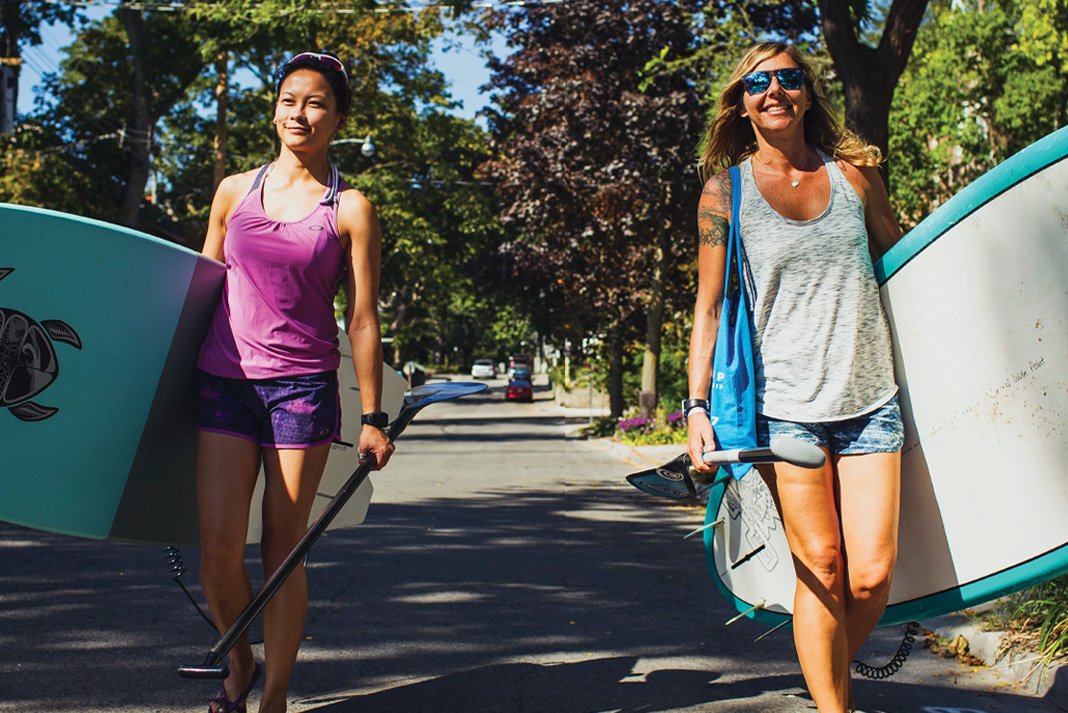
The SUPGirlz
Businesses stoking the passion for beginners play a key role. Lee first saw paddleboarders while vacationing in Hawaii. She thought those people learning to surf on bigger boards and with paddles in their hands were onto something. It wasn’t until she was back home in Toronto that she got hooked by taking a course with SUPGirlz, Janna Van Hoof ’s local school.
Van Hoof is a globe-trotting surfer who grew up in Florida. Like Lee, she got the paddleboarding bug in Hawaii, while living for a spell in Maui. After settling down in Toronto, she turned to paddleboarding as a way to stay in touch with the water and make the most of a short summer.
Van Hoof started SUPGirlz in 2008 out of a rented apartment near Kew Balmy Beach in Toronto’s east end. She became the face of one of the first paddleboarding businesses in the city, predating the big SUP boom by almost half a decade. With a humble garage as a base and the entire Great Lake as a free playground to teach upon, she’s been fulfilling her mission of “bringing surf culture to the city via standup paddleboards” ever since.
“Interest in paddleboarding has grown in the decade since I opened SUPGirlz,” says Van Hoof. Back then, barely anyone outside of California knew what SUP was. “Now I see paddleboarders everywhere.”
“I started to teach people to SUP because I wanted to teach people how to surf,” she adds. “With a paddle in their hands people are much stronger. Your pop-up doesn’t have to be perfect anymore. I can teach people what used to take two years in a week. The curve to take up long boarding is way shorter.”
The “Girlz” part of the business name sparks some confusion, to Van Hoof ’s amusement. People often ask, “Are guys allowed?” They are—SUPGirlz also has male instructors—but Van Hoof embraces the ladies-first philosophy as a refreshing change in a sport with maledominated roots.
“The guys have had surfing for years,” she says. “I don’t mind sending some energy towards raising the status of women on the water.” Anecdotally, women make up the largest segment of the recreational paddleboarding demographic. This gender split is echoed in yoga and running communities. And like yoga and running, paddleboarding isn’t simply an activity when you’re an enthusiast—it can be your social circle and your lifestyle.
It’s what SUPGirlz does beyond the basics of just providing skills and equipment that has helped build the local scene. Operating more like a community center or fitness studio than a mere outfitter, SUPGirlz offers more than a dozen different types of classes. There are the typical intros for first-timers, sunrise yoga sessions and boot camp fitness classes. Then there are kids camps, three-hour adventure paddles, surf clinics, holiday fireworks-viewing trips and fullmoon night paddles with 1,000-lumen light bars strapped to the boards. There are also occasional weekends away and international surf trips.
Social paddles are an anchor where friendships are built. Regulars can paddle with their dogs and newbies can mix with veterans. Clients don’t just pick up a rental board, they gather by the SUPGirlz garage for birthdays barbecues and they get together after paddling at the local bakeshop for a latte and a snack.
Paddleboarding is the new yoga or gym session. It’s become something you do daily in the city for mind-body-soul fitness, and it comes with the bonus of getting in touch with nature, unlike most urban hobbies.
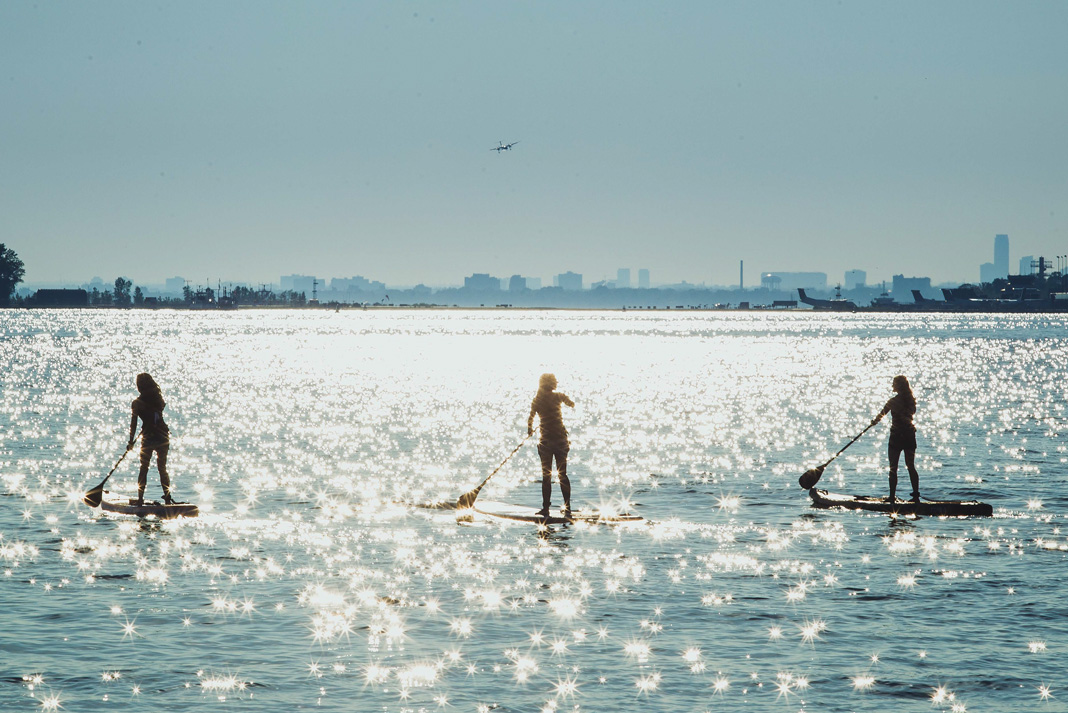
Political Pressure
Entrepreneurs catering to the growing SUP demand are being met with support from city government keen to turn Toronto into a paddlefriendly city. The aim is to develop the waterfront for paddlers much the way progressive cities everywhere are remodelling streets for cyclists. Toronto already has an advantage over many cities with 11 city beaches and 138 kilometres of shoreline, including the Toronto Islands park just offshore of downtown.
Tasked with the multi-decades revitalization of the city’s post-industrial waterfront, government-funded agency Waterfront Toronto has transformed parking lots and industrial docks into public spaces, drawing tourists and paddlers alike. Torontonians are slowly changing their own perception of their waterfront, from an industrial shoreline best avoided to embracing a recreational asset.
“Not everyone has a cottage or a place to escape to. As a city we should be making better use of our beautiful, clean lake,” says Mary-Margaret McMahon, the Toronto Beaches’ firecracker of a city councillor. McMahon initiated the RFP process that saw two new SUP rental businesses open up—one out of a trailer and the other out of a shipping container—on the Beaches Boardwalk last summer. It’s the first step in a five-year pilot project to “animate the beach.”
“The paddleboard rentals are highly successful,” adds McMahon. She hopes to see the idea expand into the city’s other waterfront neighbourhoods. “I think some Torontonians still don’t realize we have a beach down there.”
The city has also approved funding for up to 12 water access points, called recreational nodes. James Dann, Toronto’s manager of waterfront parks, says the plan grew out of working with lakefront city councillors, including McMahon, to find ways to improve free recreational access to the lake.
“We’re looking at what makes it easy to get around and paddle within your local community,” says Dann.
The project will accomplish several goals: shoreline rehabilitation to mitigate future flood damage, improving fishing habitat, and providing places for free public water access. This is great news for paddlers who sometimes find themselves launching from break walls or competing for space with motorboats at launch sites.
As construction on the access points proceeds, “people are feeling more confident about using the water as a resource,” says Dann. This has been furthered by Toronto’s beaches receiving Blue Flag labelling in 2017. Blue Flag is an international certification of cleanliness. In a city where many were told not to swim in Lake Ontario during in the ‘60s, ‘70s and ‘80s because of heavy industry operating on the shoreline, Blue Flag is a powerful signal of changing times. The water at the downtown beach that SUPGirlz favors for classes was declared safe for swimming 120 days of 122 during the official 2017 summer season.
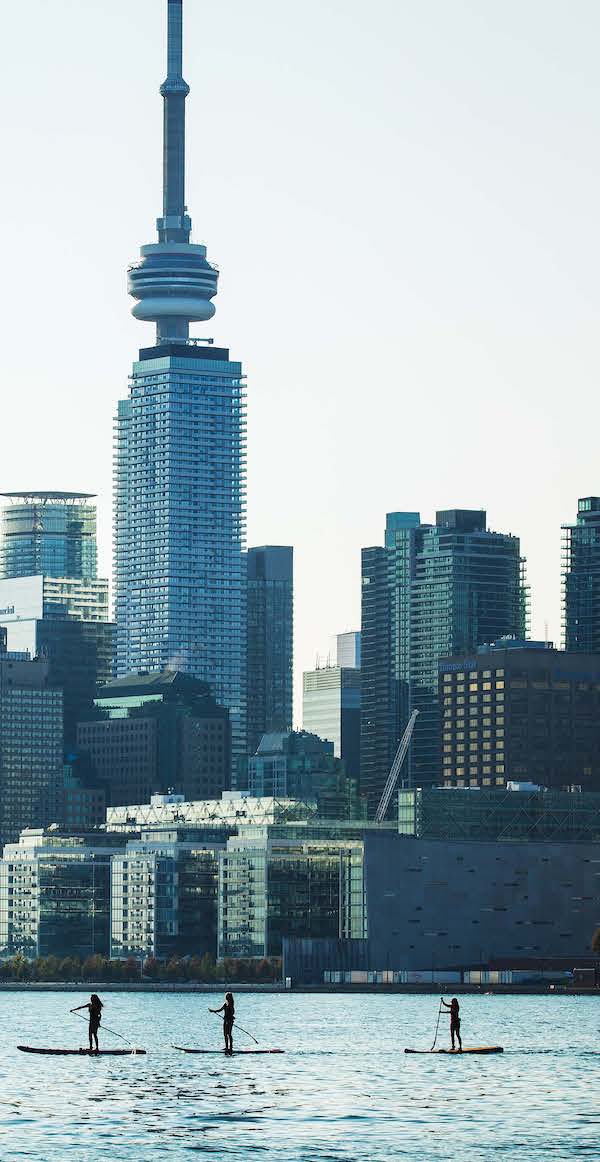
Creating Water Warriors
Even with the Blue Flag certification there’s room for improvement. Lee and Van Hoof are strong believers that for every new SUP convert, the lake gets a new defender. The growing numbers of users strengthens the case for further protection and clean-up, and for more infrastructure like rental kiosks and launch nodes. Paddleboarders have a big stake in environmental protection, according to Lee. “You’re more exposed to the water than in a canoe or kayak, so you can’t help but become an ambassador for its health,” she says.
Being an ambassador means picking up or towing in all kinds of garbage, Van Hoof adds—including, in one memorable instance, a disabled jet ski. Being an ambassador also means talking about safety, like the importance of using a leash and PFD and the unique weather hazards of the lake, and also being a good steward by encouraging others to rethink single-use plastics, which are often found floating in lakes and oceans around the world.
“I hope that everyone who comes out on the water with SUPGirlz falls in love with what they find, and is inspired to protect the water,” says Van Hoof.
Ambassadors like Van Hoof and Lee are vital. They do so much more than teach new paddlers the skills to get on the water. They’re not just creating a paddling culture and connection to nature for urbanites—they’re inspiring protection for an area that 4.5 million people call home. If all paddlers were to promote their love of water the way Van Hoof and Lee do—well, it’s the kind of thinking that changes lives and shorelines, and could maybe even protect entire ecosystems.
Tim Shuff is the former editor of Adventure Kayak magazine. When not rescuing kittens from trees, he can be found at the beach with his young family.
